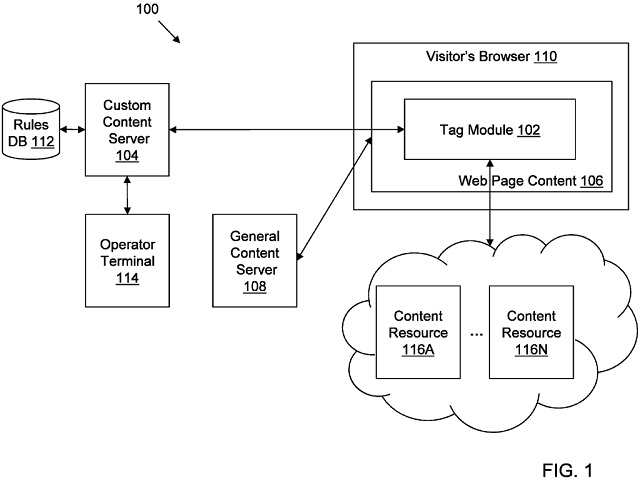This decision concerns dynamically enabling customized web content which was considered non-technical. Here are the practical takeaways from the decision T 1632/18 (Dynamically enabling customized web content/LIVEPERSON) of May 21, 2021 of Technical Board of Appeal 3.5.07:
Key takeaways
A technical effect must be adequately supported by the claim wording.
The invention
The subject-matter of the European patent application underlying the present decision was summarized by the Board in charge as follows:
The invention
1. The application relates to generating customised web page content based on a visitor's interactions with the web page, for example targeted advertising in web pages (description of the application as originally filed, paragraphs [0003], [0012], [0026], [0039], [0041], [0044], [0047]).
For example, a website provider of web page content can partner with a video company to incorporate video content such as advertisements into the website provider's web pages without modifying the original Hypertext Markup Language (HTML) code of the web pages (description, paragraph [0043]). A web page visitor's interactions with a website can be stored as a cookie (paragraphs [0045] to [0048]).
In one implementation, the content of a web page already includes a tag in HTML code that references (e.g. with a URL link) a JavaScript file (the "default tag code") on a custom content server different from the website's server (i.e. the general content server; paragraphs [0022], [0043]). The website provider can create rules that cause video content (i.e. the new content) to be downloaded from a custom content server and added into web page content using the tag. For example, the website provider can configure a rule so that (upon the occurrence of a condition) video code is uploaded to, and executed on, the visitor's browser, resulting in the video content being integrated into web page content without the visitor having to navigate away from the web page (paragraph [0043]).

Fig. 1 of WO 2011/127049 A1
Here is how the invention was defined in claim 1:
Claim 1 (main request - itemisation added by the board)
"[A] A computer-implemented method, comprising:
[B] storing a set of rules, at a custom content server, wherein a rule is associated with a condition, wherein a rule defines when to transmit customized webpage data, and wherein customized webpage data corresponds to an interaction with a webpage;
[C] receiving, at the custom content server, a request for a default tag code, wherein the request is associated with loading webpage data from a general content server on a computing device, wherein the webpage data includes original content data and a tag, wherein the tag is configured to facilitate communication between the computing device and the custom content server, wherein when the webpage data from the general content server is loaded on the computing device, the computing device displays a webpage corresponding to the original content data and the tag causes the request for the default tag code to be transmitted to the custom content server;
[D] transmitting the default tag code, wherein when the default tag code is received at the computing device, the default tag code is executed, wherein executing the default tag code generates a tag module that is stored in the computing device, wherein the default tag code includes instructions that configure the tag module to monitor an interaction with the webpage, and wherein the tag module is associated with a tag identifier;
[E] receiving behaviour data depicting interactions with the webpage, wherein the behaviour data is generated and appended to the tag identifier associated with the tag module when the tag module detects an interaction;
[F] selecting a rule from the stored set of rules, wherein selecting includes using the tag identifier, and wherein the rule defines customized webpage data;
[G] determining, based on the received behaviour data, whether the behavior data appended to the tag identifier satisfies the condition associated with the rule; and
[H] transmitting the customized webpage data when the condition associated with the rule has been satisfied."
Is it patentable?
The Board in charge identified three distinguishing features over the closest prior art document D1:
2.5 The claimed invention thus differs from the method of document D1 in the following distinguishing features:
DF1 The rules and the web page data are stored on different servers (custom content server and general content server), and the (client) computing device communicates with both servers.
DF2 The web page requested from the general content server contains a tag configured to facilitate communication between the computing device and the custom content server, the tag causing a request for the default tag code to be transmitted to the custom content server, which then receives that request.
DF3 The tag module is associated with an identifier to which the behaviour data (of the user's interaction) is appended and which is used for selecting a rule from the set of rules stored on the custom content server.
In the statement of grounds of appeal, the appellant argued the technical effect and the objective technical problem to be solved as follows:
2.6 ... the technical effect was that it was simpler to install and maintain customisation of web page content. Thus, an objective technical problem to be solved could be formulated as how to provide a method for dynamically customising web page content which is simpler to install and maintain.
However, in the written proceedings, the Board in charge did not agree and formulated the technical problem underlying the present application in a different way which is in accordance with what is described in the description:
1.6.1 ... Consequently, the board finds that the claimed method solves the more specific problem (see paragraphs [0043] and [0044] of the description) of how to allow a third party company (such as an advertising company) to customise the behaviour of a website (as known from document D1) for each individual visitor by incorporating third party content into web page content of a website provider.
In the written reply to the Board's communication, the appellant reformulated the technical problem and argued that the distinguishing features provide the technical effect of reducing the load of the general content server:
2.7 In its written reply to the board's communication, the appellant argued that the distinguishing features provided the technical effect of reducing the load of the general content server.
Again, the Board did not agree due to the following two reasons:
2.8 In the circumstances of the present case, the board does not recognise the alleged effect of load reduction as a technical effect. Firstly, there is no disclosure in the application as filed regarding this effect. Secondly, the board does not consider that moving processing tasks from the general content server to the custom content server in order to bring a task under the administrative control of a third party which controls the custom content server, as in the present case, can be regarded as a technical consideration.
During the oral hearing, the appellant once more reformulated the technical problem:
2.10 The appellant then reformulated the problem, during the oral proceedings, as "how to implement a scalable computer system in which a content provider can incorporate customised web page content into general web page content of different web page providers".
In the hearing, the Board expressed that a solution to this problem is not reflected by the claim wording:
2.10.1 As discussed at the oral proceedings, the board does not find any support for scalability with respect to customers in the wording of claim 1 ...
As a result, the Board was not convinced that the distinguishing features contribute to a technical effect or are based on further technical considerations. Hence, the appeal was dismissed due to lack of inventive step in view of D1.
The content of this article is intended to provide a general guide to the subject matter. Specialist advice should be sought about your specific circumstances.

